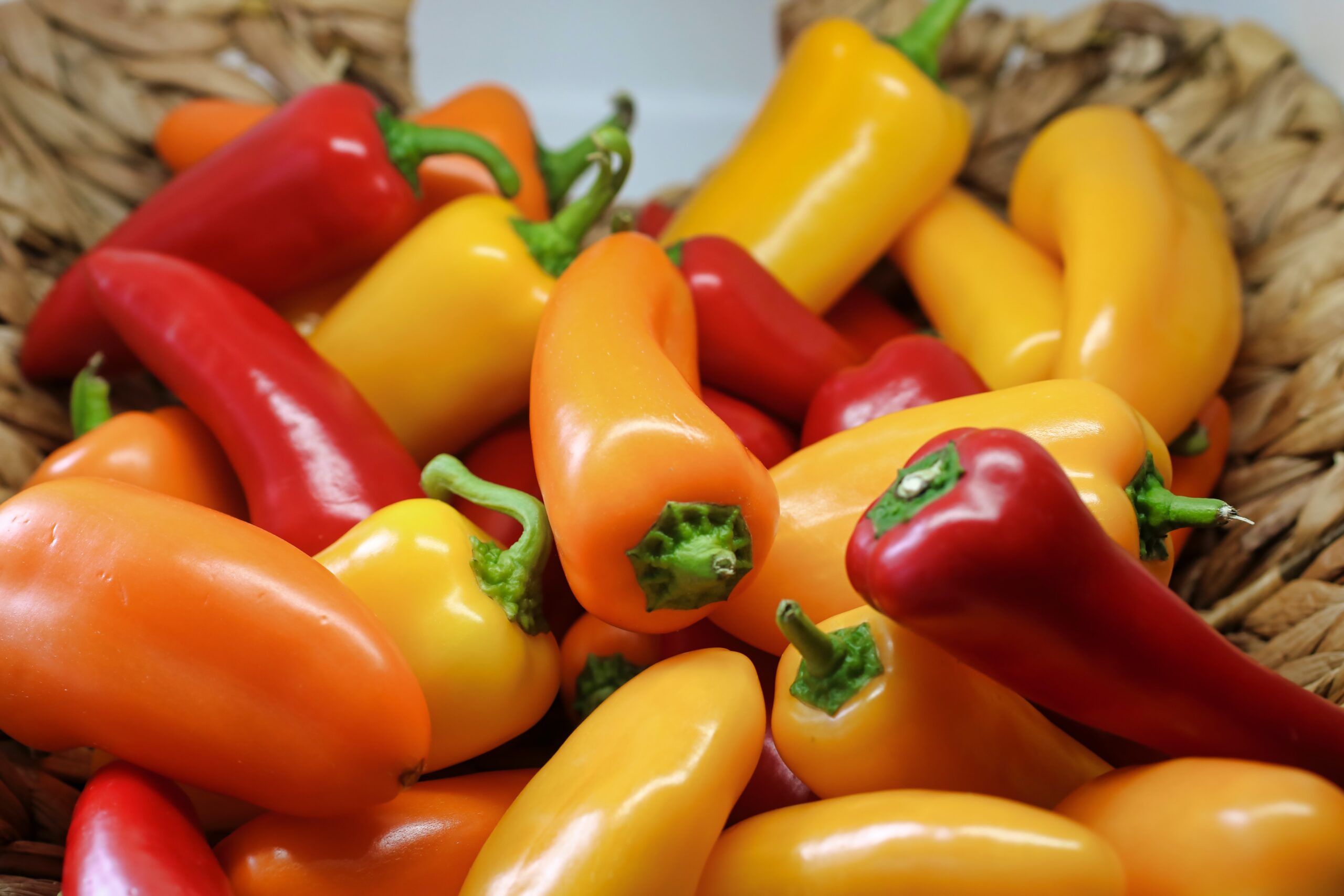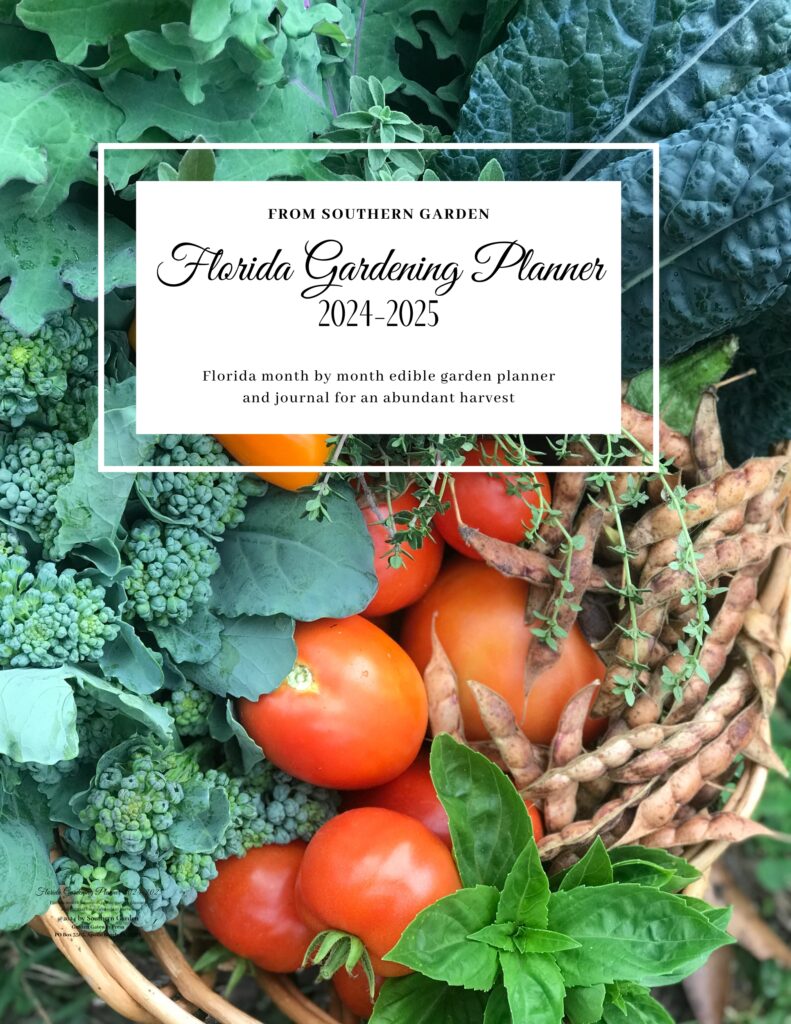Growing sweet peppers from seed takes patience, but there’s a reason why they’re a favorite of so many gardeners. Along with a huge variety of peppers available, these beauties are prolific with just a little care.
Bell peppers, or sweet peppers, are part of the Solanaceae family, the same family that includes tomatoes, eggplants, and potatoes. Depending on where you live, the ideal time to start these peppers from seed varies.
When to Start Sweet Peppers from Seed
The first trick to growing peppers is knowing when to start them from seed.
Zones 3-5: In these colder regions, kickstart your sweet pepper seeds indoors about 8-10 weeks before the last expected frost. This usually falls around late February to early March.
Zones 6-8: For folks living in milder climates, begin the indoor seeding process 6-8 weeks before your last frost, which typically occurs around mid to late March.
Zones 9-12: Lucky gardeners in warmer zones can directly sow sweet pepper seeds into their gardens from late winter to early spring. However, we recommend starting them indoors about 8 weeks before planting out.

Starting Sweet Pepper Seeds Indoors:
The next step in successfully starting sweet pepper seeds indoors is selecting an appropriate growing medium.
Opt for a high-quality seed starting mix that offers good drainage. This mix should be specifically designed for starting seeds, ensuring that it provides the right balance of moisture retention and aeration.
You can purchase a commercial brand or mix your own using 2 parts coconut coir and 1 part perlite, plus some compost, vermicompost, or slow-release organic fertilizer.
Planting Depth and Container
You can use individual cells in seed trays or soil blocks. Aim to plant the seeds at a depth of approximately 1/4 inch. This depth allows for proper germination and ensures that the emerging seedlings will have easy access to oxygen and light.
Ensuring Good Seed-to-Soil Contact
After placing the seeds in the growing medium, gently press down on the soil. This step is crucial for establishing solid seed-to-soil contact.
It helps prevent air gaps around the seeds, ensuring that they have consistent access to moisture and nutrients.
Maintaining Soil Moisture
Sweet pepper seeds require consistent moisture for germination. It’s important to keep the soil evenly moist, but avoid overwatering, as this can lead to waterlogged conditions that may harm the seeds.
A good practice is to use a spray bottle to mist the soil surface if needed to maintain proper moisture levels.
Creating a Warm Environment
Sweet peppers thrive in warm conditions, and providing a consistent temperature is essential for successful germination. Aim to maintain a temperature range of 70-80°F (21-27°C) for the growing medium.
If your indoor environment is cooler, consider using a heating mat designed for seed starting to ensure the desired warmth.
Proper Lighting
Adequate light is crucial for healthy seedling development. Place the seed trays in a well-lit location where they can receive 12-16 hours of bright, indirect light each day.
If natural sunlight is insufficient, you may need to supplement with grow lights to ensure that the seedlings receive the necessary light energy for robust growth.
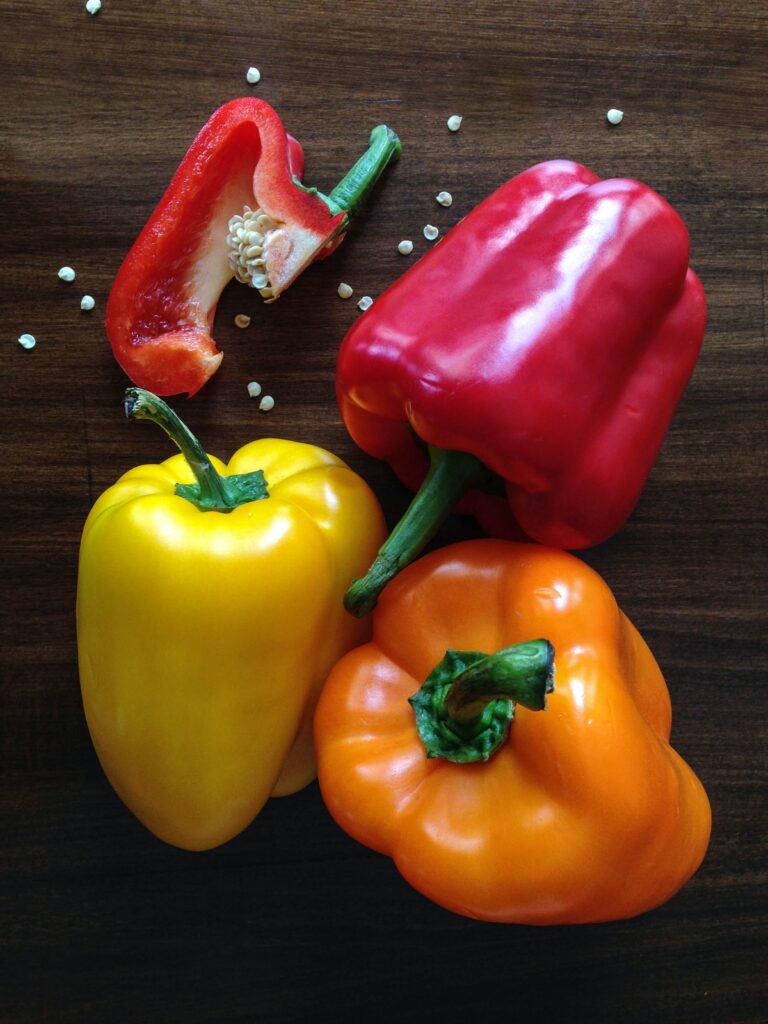
Knowing When Your Sweet Pepper Plants Are Ready to Plant Out
Determining the right time for transplanting sweet pepper plants into your garden is important for their successful growth.
Wait for Leaf Development
Sweet pepper plants typically need to reach a specific stage of growth before they are ready for outdoor transplantation. Look for the appearance of 2-4 true leaves on your pepper seedlings. These leaves will be larger and distinct from the initial cotyledon leaves.
Height and Size
In addition to leaf development, assess the height and overall size of your seedlings. Mature sweet pepper seedlings should generally be around 4-6 inches (10-15 cm) tall. This size indicates that they have developed sufficient root systems to support transplanting.
Healthy Appearance
Inspect the overall health of your seedlings. They should exhibit robust and sturdy growth without any signs of stress or disease. Avoid transplanting seedlings that appear weak, diseased, or damaged.
Outdoor Conditions
Consider the local weather and climate conditions in your area. Transplant sweet pepper seedlings after the last expected frost date for your region. Planting too early can expose them to cold temperatures, which may stunt their growth or cause damage. For peppers, it’s better to plant a little late than too early.
Time It Right
Transplant your sweet pepper seedlings into the garden during a period of mild weather and when the soil has warmed up adequately. Generally, this falls in the late spring or early summer, but it may vary depending on your location and local climate.
Preparing the Garden Bed for Sweet Pepper Plants
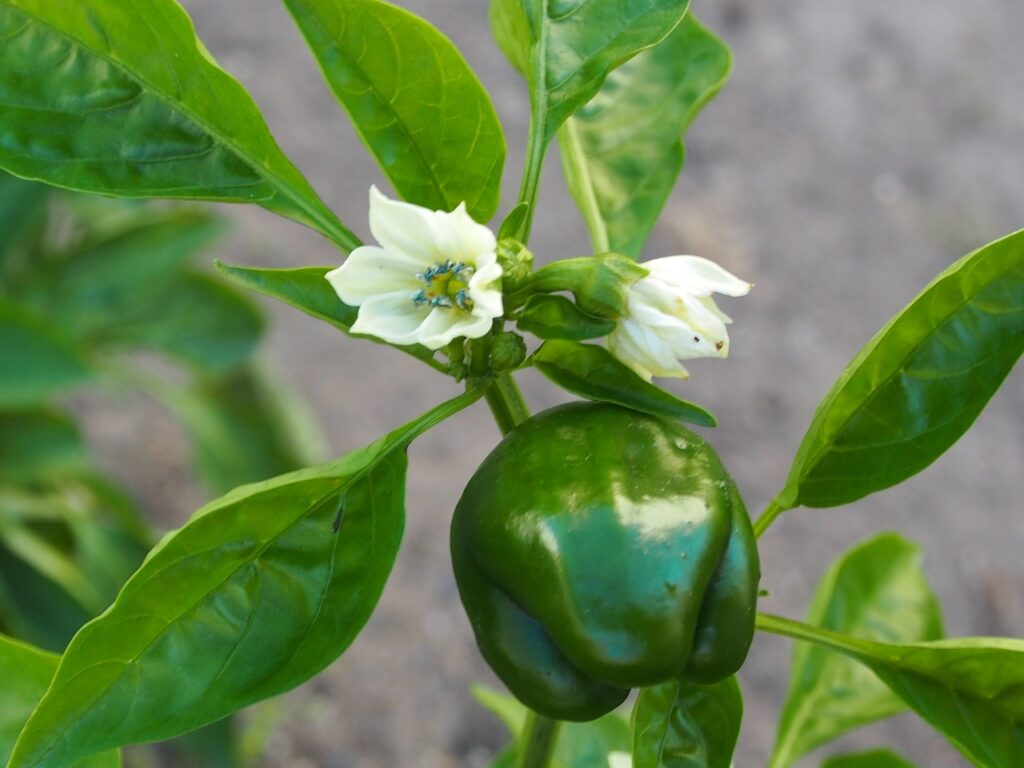
Properly preparing the garden bed is a crucial step in ensuring the success of your sweet pepper plants. Follow these detailed instructions:
Location Selection
Begin by carefully choosing a suitable location in your garden for planting sweet peppers. Opt for a spot that receives full sunlight, as sweet peppers thrive in sunny conditions. Ensure that the area is well-draining to prevent waterlogging.
Crop Rotation
To minimize the risk of soil-borne diseases and pests, avoid planting sweet peppers in the same location where members of the Solanaceae family, such as tomatoes or eggplants, grew during the previous season. Crop rotation can help maintain soil health.
Soil Preparation
Prepare the soil by loosening the soil gently with a garden fork. We generally do no recommend tilling any established garden bed, as it destroys the soil life and soil structure.
Remove any weeds, rocks, or debris during this process.
Soil Amendment
Enhance the soil’s fertility by adding a layer of well-rotted organic matter or compost. This amendment enriches the soil with essential nutrients and improves its water-holding capacity.
Spacing Consideration
Sweet pepper plants require sufficient space for healthy growth. Space your pepper plants 18-24 inches (45-60 cm) apart in rows or raised beds. This spacing allows for proper air circulation and minimizes competition for nutrients and sunlight.
Support Structures
Depending on the pepper variety and its potential height, consider providing support structures. Stakes or tomato cages can help keep the plants upright as they grow, preventing them from bending or breaking under the weight of fruit.
Hardening Off Your Sweet Pepper Plants
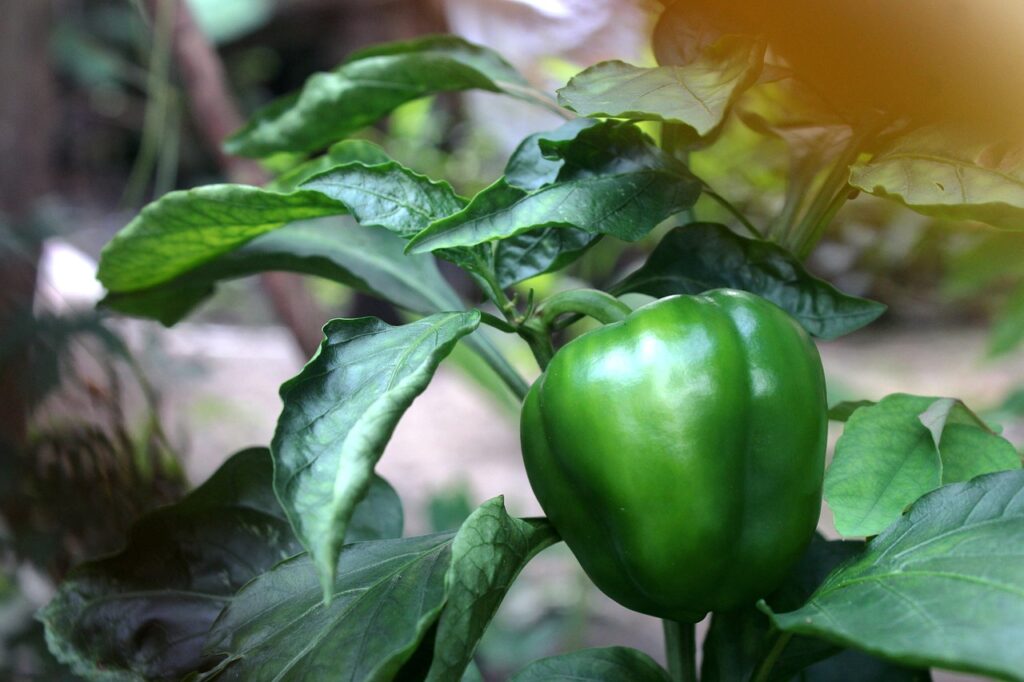
Before planting out your peppers, allow them to become accustomed to the conditions of the outdoors.
Timing
Plan to start the hardening-off process approximately 7-10 days before you intend to transplant your sweet pepper plants into the garden. This timing allows the seedlings to gradually acclimate to outdoor conditions.
Begin Gradually
On the first day, place your sweet pepper seedlings outdoors in a sheltered location with indirect sunlight for just a few hours. Choose a spot that is protected from strong winds.
Extend Exposure
Each subsequent day, increase the time your seedlings spend outdoors by an hour or two. Gradually expose them to longer periods of sunlight and outdoor temperatures.
Monitoring
While your seedlings are outdoors, closely monitor them for signs of stress. Watch for wilting, yellowing leaves, or any other unusual symptoms. If you notice any issues, consider shortening the outdoor exposure time.
Temperature Considerations
Keep an eye on the weather forecast during the hardening-off period. If unseasonably cold or harsh weather is expected, bring your seedlings inside or provide additional protection.
Adjust Light Conditions
As the days progress, gradually increase the exposure to direct sunlight. This will help your seedlings adapt to the stronger light intensity they will encounter in the garden.
Watering
Continue to water your seedlings as needed during the hardening-off process. Ensure that the soil remains consistently moist but not waterlogged. Be especially vigilant on sunny and windy days when soil moisture can quickly evaporate.
Protection from Pests
Be mindful of potential pests during the hardening-off period. Protect your seedlings from insects that may be attracted to them while outdoors.
Planting Sweet Pepper Plants in the Garden
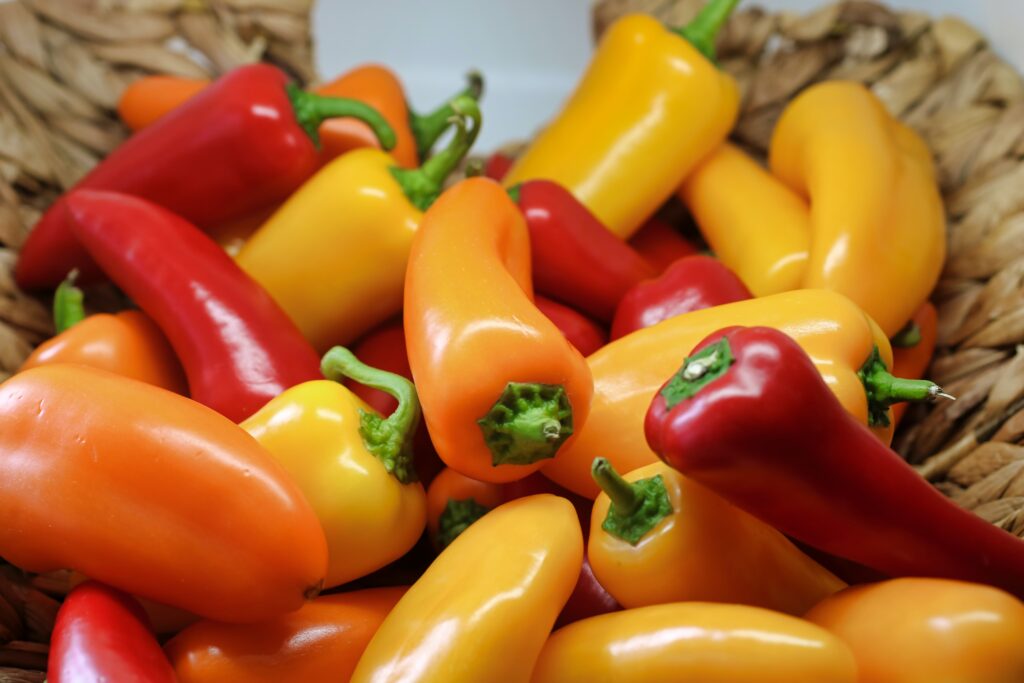
Once your plants are hardened off, it’s time to plant them in your prepared garden beds.
Planting Depth
Begin by digging holes for your sweet pepper plants. These holes should be approximately the same depth as the containers or root balls of your seedlings.
Gently remove the seedlings from their containers, taking care not to damage the roots, and place them in the prepared holes.
Spacing
Space your sweet pepper plants 18-24 inches (45-60 cm) apart in rows or raised beds.
Adequate spacing allows for proper air circulation and prevents overcrowding, which can lead to disease and reduced yields.
Mulching
Apply a layer of organic mulch, such as straw, hay, or compost, around the base of your sweet pepper plants.
Mulch helps retain soil moisture, suppresses weeds, and regulates soil temperature, all of which contribute to healthier plants.
Watering After Planting
Water the newly transplanted sweet pepper plants thoroughly after planting. Provide enough water to saturate the root zone. Subsequent watering should be consistent to maintain even moisture levels.
Depth of Planting
Ensure that the sweet pepper plants are planted at the same depth as they were in their containers. Planting too deeply can hinder growth, while planting too shallowly may lead to instability.
Fertilization
Avoid fertilizing sweet pepper plants at the time of planting. Wait until the plants have established themselves in the garden, typically after 2-3 weeks, before applying a balanced, slow-release fertilizer according to package instructions.
Watering Schedule
Sweet pepper plants prefer consistent moisture. Ensure that the soil remains consistently moist but not waterlogged throughout the growing season. Be mindful of dry spells, as consistent watering is essential for fruit development.
Proper planting techniques, spacing, and care will contribute to healthy growth and a bountiful pepper harvest.
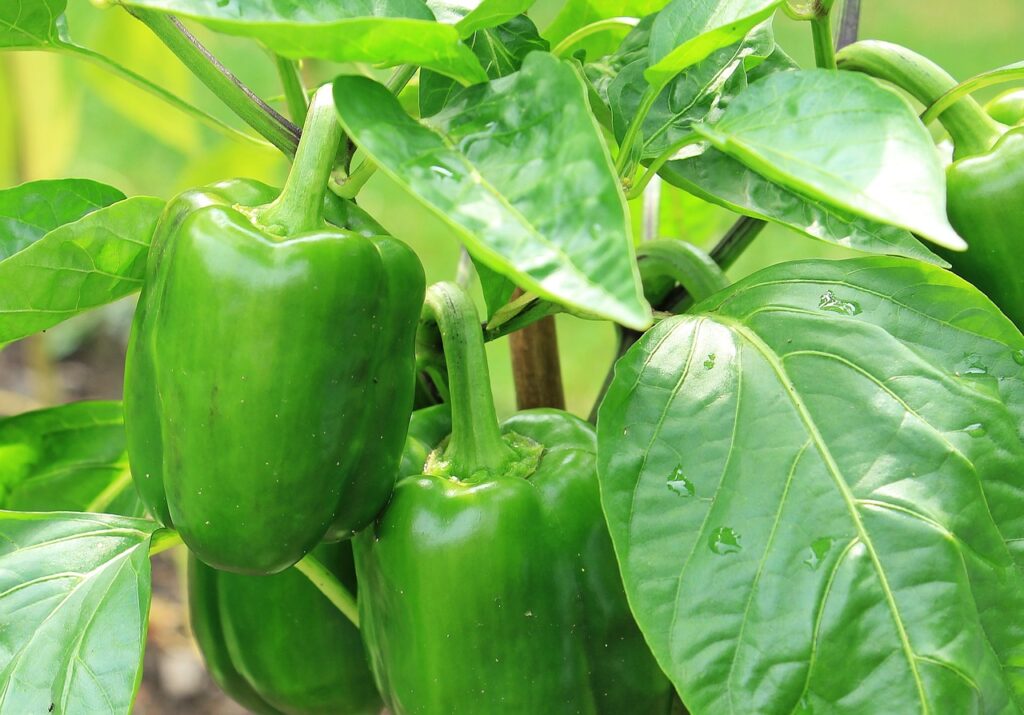
Caring for Sweet Pepper Plants
For the most abundant harvest, good care for your plants is needed.
Watering
Ensure consistent soil moisture for your sweet pepper plants, avoiding both drought and waterlogging. Water at the base of the plants early in the day to allow foliage to dry before evening, reducing the risk of fungal diseases.
Aim for deep watering sessions, ensuring the root zone receives adequate moisture.
Feeding
To provide essential nutrients, fertilize sweet pepper plants with a slow-release organic fertilizer or side-dress with compost or composted manure.
Apply fertilizer after the plants are established, typically 2-3 weeks post-transplanting.
Once blooms appear, feed again with a slow-release or liquid fertilizer formulated for vegetables, such as a tomato food.
Be cautious not to overapply nitrogen, as excessive growth of foliage can hinder fruit production.
Weeding
Regularly remove weeds from around sweet pepper plants to prevent competition for nutrients and water. Cutting them rather than pulling them will add organic matter to your soil.
Applying more mulch around the base of plants to suppress weed growth and conserve soil moisture.
Pruning
Monitor plant growth and prune as necessary to promote air circulation and reduce the risk of disease.
Remove overcrowded branches and promptly eliminate dead or diseased foliage to prevent the spread of pathogens.
Pinch back the first flowers to encourage stronger plant growth. You can also prune back the first leader stems to encourage branching.
Pest Management
Routinely inspect plants for common pests like aphids, whitefly, spider mites, or caterpillars.
Implement organic pest control methods, such as bt for caterpillars or Spinosad for whitefly.
Encourage beneficial insects like ladybugs and lacewings to assist with pest control by avoiding synthetic pesticides.
Disease Prevention
To minimize the risk of fungal diseases, ensure adequate spacing and proper pruning to maintain air circulation around plants.
Water at the base of plants rather than overhead to reduce moisture on the foliage.
Apply copper-based fungicides judiciously for specific diseases like blight.
Additional Tips
Consider companion planting strategies to deter pests and enhance overall garden health. French Marigolds help deter root-knot nematodes, and Cosmos attract pollinators.
When and How to Harvest Sweet Peppers
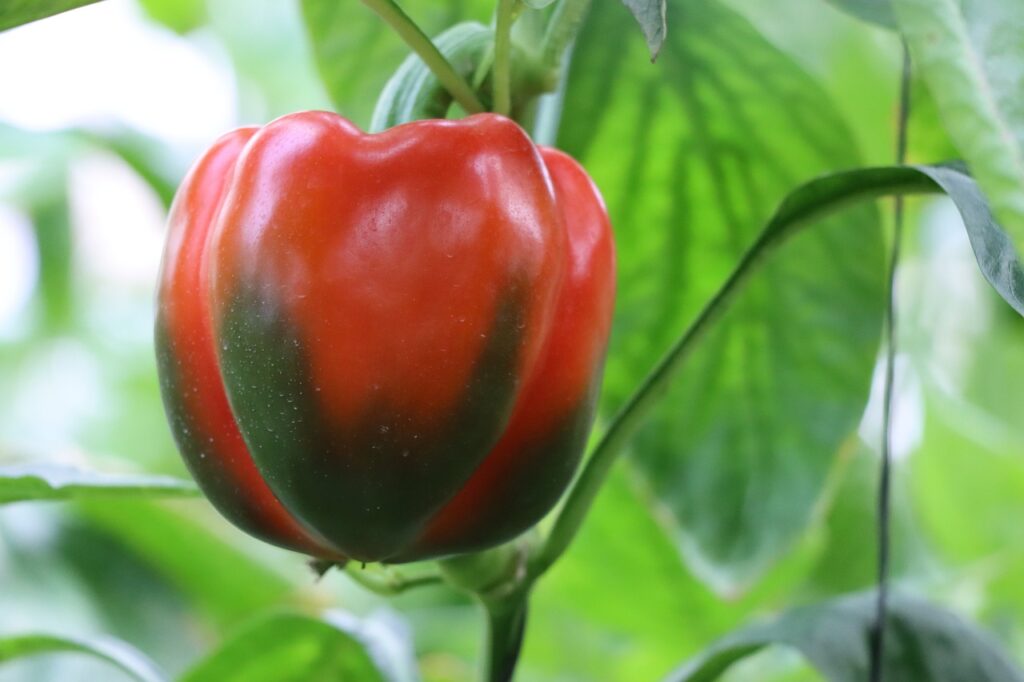
Sweet peppers can usually be harvested once they reach an adequate size. While they are edible green, most develop a sweeter flavor with further ripening.
Determining Ripeness
Sweet peppers are ready for harvest when they have achieved their desired size and color. Wait until the peppers have fully changed color according to their variety.
For instance, green peppers will typically turn red, yellow, orange, or another color based on the variety.
Size is also an indicator; sweet peppers should be firm and glossy with vibrant colors, feeling heavy for their size.
Harvesting Tools
To avoid damaging the plant and the peppers, use clean, sharp pruning shears or scissors to cut the peppers from the plant.
Snip the pepper stem carefully, leaving a small portion of the stem attached. This small stem “handle” helps prolong the peppers’ shelf life and reduces the risk of damaging the fruit during harvest.
Gentle Handling
Handle sweet peppers gently to prevent bruising or puncturing, which can lead to spoilage.
Avoid pulling or twisting the peppers off the plant, as this can damage the stems and the plant itself.
Harvesting Techniques
If the peppers have not fully ripened on the plant but you need to harvest due to impending frost or other reasons, pick them when they are mature but still green.
In some cases, you can encourage additional fruiting by harvesting peppers at various stages of ripeness.
Regular Harvesting
To encourage continued production, harvest sweet peppers regularly throughout the growing season.
Check the plants every few days for ripe peppers to ensure you collect them at their peak.
Overripe Peppers
If you notice any overripe or wrinkled peppers on the plant, remove them promptly. Overripe peppers can attract pests and sap nutrients from the healthy ones.
How to Clean and Store Home-Grown Sweet Peppers
Cleaning and properly storing home-grown sweet peppers is essential for preserving their freshness and flavor. Follow these detailed instructions for optimal results:
Cleaning
Wash the harvested sweet peppers thoroughly under cool running water to remove any dirt, debris, or potential pests.
Gently scrub the surface with a soft brush or cloth to ensure cleanliness.
Pat the peppers dry with a clean towel or paper towels.
Storage Options
There are several ways you can store your home-grown peppers.
Refrigeration
For short-term storage (up to 2 weeks), place the cleaned sweet peppers in a perforated plastic bag or a vegetable crisper drawer in the refrigerator. The perforations allow for proper air circulation and moisture control.
Freezing
To extend the shelf life considerably, you can freeze sweet peppers. Start by removing the seeds and membranes, then chop or slice the peppers to your desired size.
Spread them out on a baking sheet and flash-freeze for a few hours before transferring to airtight containers or freezer bags. Properly sealed, frozen sweet peppers can last up to 12 months in the freezer.
Avoiding Moisture Buildup
Ensure that sweet peppers are thoroughly dry before storing them, as moisture can lead to mold and spoilage.
Replace any wet or damp paper towels or liners in the storage container to prevent excess moisture accumulation.
Room Temperature Storage:
If you intend to use your sweet peppers within a few days, storing them at room temperature is acceptable. Keep them in a cool, dry place away from direct sunlight.
Monitoring for Freshness
Regularly inspect stored sweet peppers for any signs of spoilage, such as mold, soft spots, or off odors. Remove any affected peppers promptly to prevent contamination of others.
How to Cook with Sweet Peppers
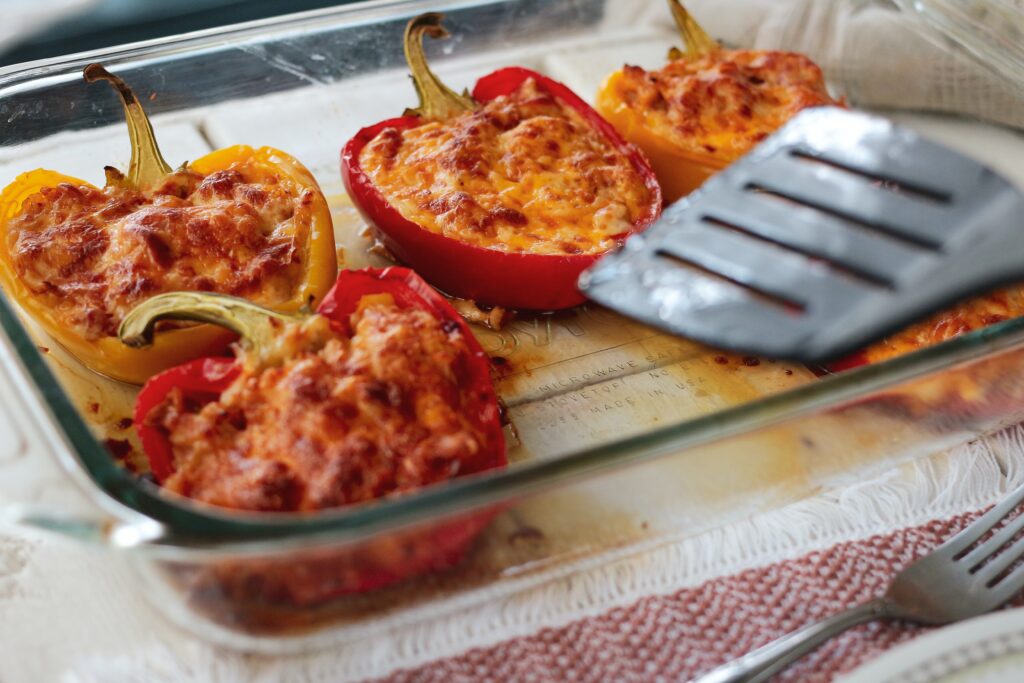
Sweet peppers are versatile ingredients that add vibrant colors, delightful flavors, and a touch of sweetness to a wide range of dishes. Here are five well-loved recipes that make excellent use of sweet peppers:
1. Stuffed Bell Peppers: Stuffed bell peppers are a classic dish where sweet bell peppers serve as both the vessel and a delicious part of the filling. Commonly stuffed with a mixture of ground meat, rice, onions, and herbs, these peppers are then baked until tender. Variations with vegetarian or vegan fillings are also popular.
2. Pepper Fajitas: Sweet bell peppers are a key ingredient in fajitas, a Tex-Mex favorite. Sliced bell peppers are sautéed with onions and strips of meat, often chicken or beef, then seasoned with spices and served in tortillas. Vegetarian versions using tofu or mushrooms are also popular.
3. Ratatouille: This classic French Provencal stew showcases sweet peppers alongside other summer vegetables like eggplant, zucchini, and tomatoes. Sautéed or roasted peppers add a sweet and savory element to this hearty dish.
4. Pepperonata: A traditional Italian condiment, pepperonata combines sweet bell peppers, onions, and tomatoes sautéed in olive oil.
It can be served as a topping for bruschetta, a side dish, or even as a sandwich filling.
5. Sweet and Sour Stir-Fry: Sweet peppers are a staple in many Asian-inspired stir-fry dishes. The vibrant colors of bell peppers add visual appeal, while their natural sweetness balances the savory and tangy flavors of the stir-fry
sauce. Commonly paired with ingredients like chicken, tofu, or shrimp, sweet and sour stir-fry is a delightful and quick meal option.
These are just a few examples of how sweet peppers can be used in a variety of cuisines and cooking styles.
Whether you’re roasting them for a smoky flavor, using them raw in salads, or incorporating them into hearty stews and casseroles, sweet peppers elevate the taste and presentation of many dishes.
